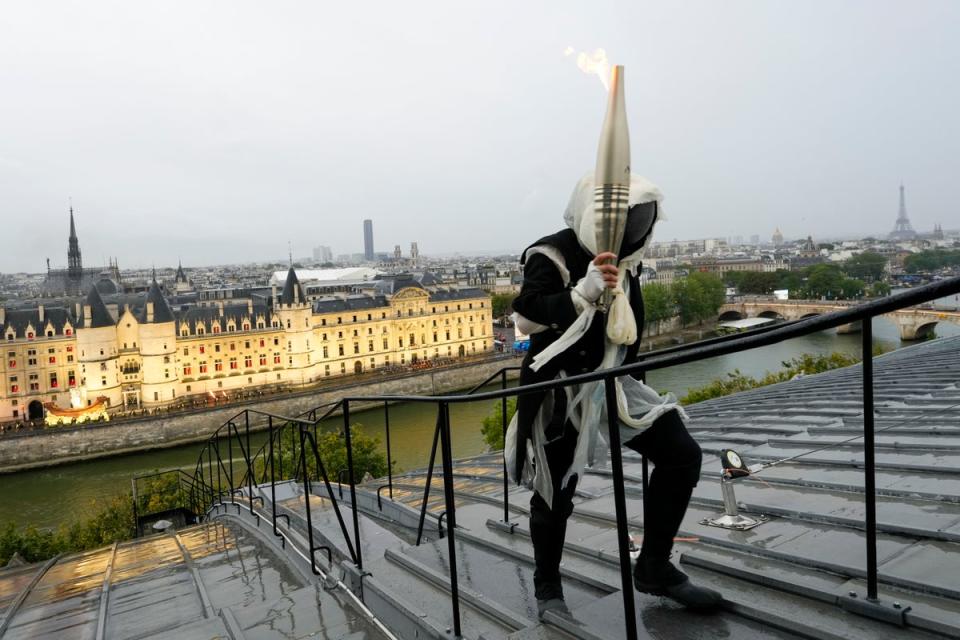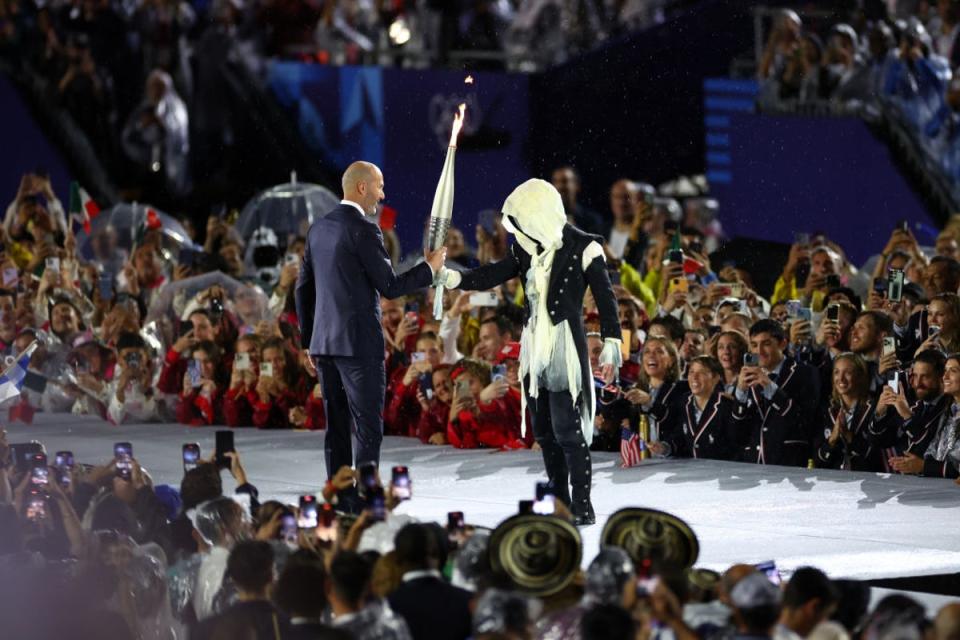The Olympics Masked Torchbearer has become a powerful symbol in recent years, representing unity, resilience, and the global fight against challenges faced by humanity. The tradition of the Olympic torch relay is one of the most iconic events in the history of sports, symbolizing peace, harmony, and the shared spirit of competition. However, recent adaptations, such as the introduction of masked torchbearers, have added new dimensions to this historic tradition.
As the world continues to navigate unprecedented challenges, the Olympics have adapted to ensure safety while preserving the essence of the games. The presence of a masked torchbearer is not just a precautionary measure but a testament to the determination of nations to overcome adversity. This article explores the significance of the Olympics Masked Torchbearer and its role in modern Olympic history.
In this article, we will delve into the history of the Olympic torch relay, the evolution of its traditions, and the reasons behind the introduction of masked torchbearers. We will also examine how this adaptation aligns with the core values of the Olympic movement and its impact on global audiences. Let's begin our journey into the world of the Olympics Masked Torchbearer.
Read also:Jim Parsons Husband A Comprehensive Look At Their Love Story
Table of Contents
- History of the Olympic Torch Relay
- Evolution of Traditions
- Significance of the Masked Torchbearer
- Safety Measures in Modern Olympics
- Symbolism Behind the Mask
- Global Response to the Masked Torchbearer
- Olympic Values and the Masked Torchbearer
- Impact on the Sports Community
- Future of Olympic Traditions
- Conclusion
History of the Olympic Torch Relay
The Olympic torch relay dates back to the ancient Olympic Games in Greece, where a flame was kept burning throughout the competition to honor the Greek god Zeus. This tradition was revived for the modern Olympic Games in 1936 during the Berlin Olympics. Since then, the relay has become an integral part of the games, symbolizing the connection between the ancient and modern worlds.
The relay typically begins months before the opening ceremony, with the flame being lit in Olympia, Greece. It is then transported across various countries and cities, culminating in the host nation. The journey of the torch is a celebration of culture, diversity, and unity, involving thousands of participants who carry the flame.
Origins and Evolution
The origins of the Olympic torch relay are deeply rooted in Greek mythology. Over time, the relay has evolved to include modern elements, such as the use of technology for lighting the flame and transporting it across vast distances. The introduction of the Olympics Masked Torchbearer is one such adaptation that reflects the changing times and global challenges.
Evolution of Traditions
Traditions in the Olympics have always been subject to change, adapting to the needs of the times. From the inclusion of new sports to the adoption of technology, the games have consistently evolved to stay relevant. The introduction of the masked torchbearer is a testament to this evolution, as it addresses the need for safety while preserving the spirit of the games.
Recent editions of the Olympics have seen innovations in the relay process, such as virtual torch relays and the use of drones. These adaptations ensure that the flame continues to reach global audiences, even in challenging circumstances.
New Adaptations
- Virtual torch relay experiences
- Use of drones and other technologies
- Inclusion of masked torchbearers
Significance of the Masked Torchbearer
The introduction of the Olympics Masked Torchbearer holds significant meaning in the context of modern Olympic history. It represents the resilience of humanity in the face of adversity and serves as a reminder of the importance of global cooperation. The mask, once seen as a barrier, has become a symbol of protection and unity.
Read also:22 Aug Zodiac Sign Discover The Traits Compatibility And Secrets Of Leo
Masked torchbearers are chosen from various walks of life, representing diverse communities and cultures. Their participation highlights the inclusive nature of the Olympics and reinforces the message of equality and solidarity.
Symbolic Representation
The mask worn by the torchbearer symbolizes several key themes:
- Protection: Ensuring the safety of participants and spectators
- Unity: Bringing people together despite differences
- Resilience: Demonstrating the ability to overcome challenges
Safety Measures in Modern Olympics
Modern Olympics have implemented numerous safety measures to ensure the well-being of athletes, officials, and spectators. The use of masks during the torch relay is just one example of these measures. Other initiatives include regular testing, social distancing protocols, and the use of designated zones to minimize contact.
These safety measures are supported by scientific research and recommendations from global health organizations. The collaboration between the International Olympic Committee (IOC) and health authorities ensures that the games remain safe and enjoyable for all participants.
Scientific Backing
According to a report by the World Health Organization (WHO), wearing masks significantly reduces the transmission of airborne pathogens. This scientific evidence supports the decision to include masked torchbearers in the relay process.
Symbolism Behind the Mask
The mask worn by the Olympics Masked Torchbearer carries deep symbolic meaning. It represents a shift in societal norms and the importance of collective responsibility. In a world where health and safety are paramount, the mask serves as a reminder of our shared duty to protect one another.
Historically, masks have been used in various cultures to symbolize transformation, identity, and protection. The incorporation of masks into the Olympic tradition adds a new layer of meaning to this ancient practice.
Cultural Significance
Across cultures, masks have been used in rituals, performances, and ceremonies. The Olympics Masked Torchbearer draws inspiration from these traditions, blending ancient customs with modern realities. This fusion creates a powerful narrative that resonates with global audiences.
Global Response to the Masked Torchbearer
The introduction of the Olympics Masked Torchbearer has garnered mixed reactions from around the world. While some view it as a necessary adaptation, others see it as a departure from tradition. Despite these differing opinions, the overall response has been positive, with many recognizing the importance of safety in modern sports.
Social media platforms have been instrumental in shaping public perception, with hashtags like #MaskedTorchbearer trending during the relay. The global conversation surrounding this adaptation highlights the growing awareness of health and safety issues in sports.
Public Perception
- Positive reception from health-conscious audiences
- Concerns about the impact on tradition
- Increased engagement through social media
Olympic Values and the Masked Torchbearer
The core values of the Olympic movement—excellence, friendship, and respect—are embodied by the Olympics Masked Torchbearer. By prioritizing safety and inclusivity, the torchbearer exemplifies these values in action. The relay process serves as a platform to promote these ideals on a global scale.
Through the inclusion of masked torchbearers, the Olympics reinforce their commitment to creating a safer and more equitable world. This commitment aligns with the broader goals of the IOC to promote peace and understanding through sports.
Alignment with Olympic Ideals
The Olympics Masked Torchbearer aligns with the following Olympic ideals:
- Promoting global unity
- Encouraging mutual respect
- Celebrating diversity and inclusion
Impact on the Sports Community
The introduction of the Olympics Masked Torchbearer has had a profound impact on the sports community. It has sparked conversations about the role of safety in sports and the importance of adapting traditions to meet modern needs. Athletes and sports organizations have embraced this change, recognizing its significance in shaping the future of sports.
Coaches and trainers have also incorporated safety protocols into their training regimens, ensuring that athletes are prepared for competitions in a post-pandemic world. This shift highlights the adaptability of the sports community in response to global challenges.
Adaptation in Training
Training programs now include:
- Safety protocols for athletes
- Education on health and hygiene practices
- Incorporation of virtual training sessions
Future of Olympic Traditions
As the world continues to evolve, so too will the traditions of the Olympics. The inclusion of masked torchbearers is just one example of how the games are adapting to changing circumstances. Future editions of the Olympics may see further innovations in the relay process, incorporating new technologies and practices to enhance the experience for participants and spectators alike.
The future of Olympic traditions lies in their ability to remain relevant while honoring their historical roots. By embracing change, the Olympics can continue to inspire and unite people from all corners of the globe.
Predictions for Future Relays
In the years to come, we may see:
- Enhanced virtual experiences
- Integration of augmented reality
- Continued emphasis on safety and inclusivity
Conclusion
The Olympics Masked Torchbearer represents a significant milestone in the history of the Olympic Games. It embodies the values of unity, resilience, and global cooperation, serving as a powerful symbol in a rapidly changing world. Through its inclusion, the games continue to evolve, adapting to the needs of the times while preserving their core traditions.
We invite you to share your thoughts on the Olympics Masked Torchbearer in the comments section below. Your feedback helps us understand the impact of this adaptation on global audiences. Additionally, explore other articles on our site to learn more about the fascinating world of sports and traditions.


